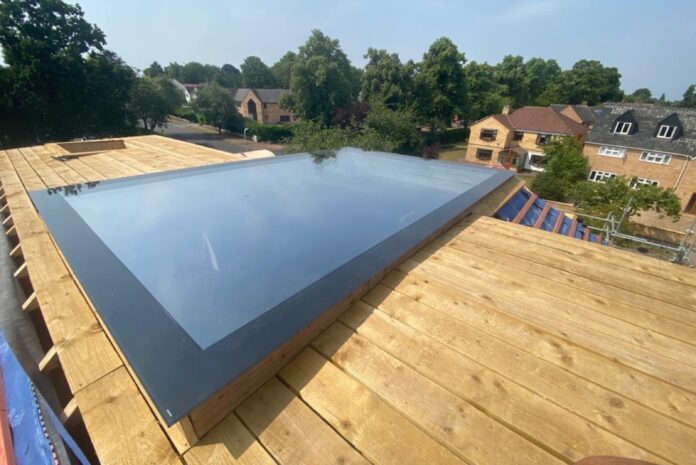As a roofer, one of the most rewarding tasks you can undertake is the installation of a skylight. This architectural feature not only enhances the aesthetic appeal of a structure but also improves the natural lighting, energy efficiency, and overall living comfort within a space. However, the process of skylight installation, while rewarding, requires precision, understanding, and careful planning. One small error can lead to leaks, drafts, or even structural damage over time.
In this article, we aim to provide a comprehensive guide to help you navigate skylight installation, ensuring your work is both effective and efficient. We’ll delve into the various types of skylights, and their unique installation requirements, and share essential tips for each phase of the installation process—from pre-installation site preparation to post-installation best practices. Whether you’re a seasoned roofer or new to the profession, this guide is designed to bolster your skylight installation skills and help you excel in your craft. Let’s dive in!
Understanding Skylights
Understanding the nuances of skylights is an essential first step in the installation process. Skylights come in various types, each with their unique installation requirements. Here are some of the most common:
- Fixed Skylights: These are non-opening skylights, designed solely for light intake. They are relatively straightforward to install but must be carefully sealed to prevent leaks.
- Ventilating Skylights: These skylights can open, either manually or electronically, to allow ventilation. Their installation requires additional attention due to the moving parts and the need for a power source in some cases.
- Tubular Skylights: Compact and versatile, tubular skylights bring light to small or hard-to-reach areas. Installation often involves complex positioning and tunnel construction to direct the light properly.
- Framed or Frameless Skylights: While framed skylights have a visible border around the glass, frameless skylights offer an uninterrupted view of the sky. The installation process for these skylights can vary depending on the framing material and design.
- Custom Skylights: These are tailor-made to suit specific architectural requirements. Their installation procedures are unique to each design and require a high level of expertise.
Selecting the proper skylight type is equally important as the installation process itself. The choice of skylight depends on several factors, such as the building design, roof structure, local climate, and the homeowner’s specific needs and preferences. By understanding the unique features and installation requirements of each skylight type, you can guide homeowners in making an informed decision, ensuring their satisfaction and the overall success of your installation project.
Pre-Installation Phase
Proper site inspection and preparation
Before the actual installation process begins, a proper site inspection and preparation are crucial. As a roofer, you’ll need to examine the structure of the roof, identify the type of roofing material, and assess the area’s condition where the skylight will be installed. Look out for any signs of damage, wear, or structural concerns that could affect the installation process. Consider taking a photo of the area for reference.
Tips for accurate skylight measurements
Accurate measurements of the skylight are paramount to a successful installation. When measuring the skylight opening, be sure to double-check your numbers for precision. The measurements should be based on the rough opening size recommended by the skylight manufacturer. Remember, an improperly sized skylight can lead to a host of issues, including water leaks and poor insulation.
Considerations for skylight positioning and orientation
Thoughtful consideration should be given to the skylight’s positioning and orientation. The placement of the skylight can greatly impact the amount of natural light admitted into the space and the overall energy efficiency of the home. For example, a skylight installed on a north-facing roof will provide fairly constant and cool illumination, while one on a south-facing roof will capture more solar heat. The building’s design, the homeowner’s light requirements, and the local climate should all factor into this decision. By carefully planning these elements in the pre-installation phase, you can set the stage for a smooth and successful skylight installation.
The Installation Process
Step-by-step Guide to Skylight Installation
Skylight installation on Pitched Roof or on Flart Roof is a task that demands precision, proper understanding, and meticulous attention to detail. Here is a general guide:
- Cut the Opening: Having double-checked measurements, proceed to carefully cut the hole for the skylight in the roof from the outside.
- Install the Skylight: Carefully place the skylight into the opening, ensuring it fits securely and is perfectly aligned.
- Seal and Insulate: Once the skylight is in position, apply appropriate flashing around the skylight to prevent potential water leakage. Subsequently, insulate the area around the skylight to optimize energy efficiency.
- Interior Finishing: Inside the building, fix the skylight’s interior frame and finish the area around the skylight in a way that aligns with the existing ceiling design.
Common Pitfalls to Avoid During Installation
During the installation process, there are common pitfalls you should be aware of and strive to avoid. Incorrectly applying the flashing, for example, can lead to water leaks, which could cause damage over time. Inadequate insulation may result in heat loss or gain, negating the energy efficiency that the skylight could potentially offer. Failing to account for the effects of condensation, particularly in humid environments or cold weather conditions, can also be problematic.
Safety Precautions to Consider During the Installation
Safety is paramount when installing a skylight. Always use the correct safety equipment such as safety harnesses when working at heights. Properly deploy ladders and stay conscious of your surroundings to avoid any unfortunate mishaps or falls. If the roof’s incline is steep or slippery, or if you’re not entirely confident in your installation skills, it’s best to employ professional assistance. Remember, safety should always come first!
Post-Installation Best Practices
Ensuring Proper Sealing and Insulation
After the installation of the skylight, one of the first things to do is to ensure the sealing and insulation around the skylight are effectively done. Proper sealing helps prevent water leakage, while efficient insulation minimizes heat loss or gain. These factors are critical to maintaining the energy efficiency of the home. Using a high-quality sealant is a smart choice, and making sure the insulation fits snugly around the skylight can make a significant difference in energy savings.
Tips for Checking the Quality of Installation
Quality assurance is crucial after completing a skylight installation. First, visually inspect the skylight from both the interior and exterior of the building to ensure it aligns perfectly with the structure. Also, check the skylight opens and closes smoothly (if it’s a venting skylight). If possible, perform a water test to check for potential leaks – carefully pour water around the skylight edges and check for any seepage. Additionally, pay attention to the skylight during different weather conditions over the subsequent days and weeks to identify any potential issues early.
Maintenance Tips for Roofers to Share with Homeowners
After successfully installing a skylight, it’s important to provide homeowners with maintenance advice to help them care for their new feature. Remind them to regularly clean the skylight glass for optimum light penetration, inspect the skylight for any signs of wear or damage, and maintain the sealing and insulation around the skylight. Instruct them about the importance of proper ventilation in preventing condensation, and recommend a schedule for professional inspection and maintenance. The better the homeowners care for their skylight, the longer it will last and the better it will perform.
Final Thoughts
To recap, skylight installation is a meticulous process that requires a firm understanding of different skylight types and their unique installation needs. Initial site inspection, accurate measurements, and considerate placement are integral to a successful setup. The installation process should be handled step-by-step, paying attention to avoid common pitfalls and ensuring safety at all times
Ensuring proper installation of skylights is a critical responsibility for roofers, which directly affects the durability, performance, and overall satisfaction homeowners derive from their skylights. Remember, a well-installed skylight not only illuminates a home but also significantly boosts its energy efficiency. Hence, a roofer’s expertise and careful handling can truly light up a home, cementing a reputation for quality workmanship and contributing to a more sustainable, energy-efficient future.













